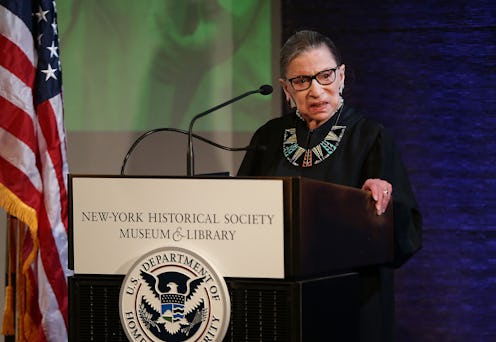News
Here's What A Supreme Court Justice's Schedule Generally Looks Like

The life of a Supreme Court Justice is one of the more mysterious political positions that exists in the United States. Supreme Court justices have the final say in legislation that can affect the country for generations, and yet their day-to-day schedule is probably unknown to the average person. If you're wondering how much Supreme Court justices work in a given year, then you might not be surprised to know that their schedules seem to be just as intriguing as the justices themselves.
It seems like the life and schedule of a Supreme Court judge is equal parts glamour and grind. The first thing to know about the justices' schedule is that they have similar situations as teachers: the Supreme Court operates on a nine-month term, which begins in October of every year and ends in late June or early July. This nine month term isn't divided into weekdays and weekends, but rather "sittings" and "recesses." During the sittings, Supreme Court justices have to show up to court, hear cases, and deliver opinions on those cases (that's the part of the Supreme Court that the American people tend to pay attention to.)
As for the recesses, that's for the Justices to consider the trials and cases and to write opinions on them. Sittings and recesses switch off in two-week intervals. This is also why you might hear about a trial that's scheduled for the Supreme Court several months from now: because of the setup of cases (and the volume of them), cases are usually scheduled multiple months, if not years, in advance.
It's hard to say just how many hours Justices spend working per week. What is known is that each month, they only have about 12 days of official responsibilities, at the most. That obviously doesn't encapsulate their full work load, though. It just reflects how often they have to literally be at work.
In addition to reviewing the cases that come before them in person, the justices are required to evaluate over 130 petitions each week to determine which cases will make it to the Supreme Court to begin with.
So the justices definitely have a lot of paperwork to sift through — but that's where the clerks come in. According to ABC News, Supreme Court clerks are the ones who do most of the work sorting through petitions and summarizing them into easy-to-read memos, and even help the justices write their opinions for cases occasionally.
Beyond their work for the Supreme Court, most justices usually spend some time giving speaking gigs all over the world; they're not technically allowed to be paid for those speeches, but they still get a free trip out of the experience and potentially secure book deals down the line.
In the summer when the term's over, you can probably guess what the judges do with their free time: they travel. In the past, Ruth Bader Ginsburg has spent her time teaching classes in the Mediterranean (not to mention keeping her strength up with her famous workouts), according to Quartz, and Anthony Kennedy has taught summer school in Austria.